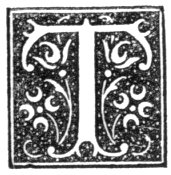
Sacred Texts Legends and Sagas Celtic Index Previous Next

"Tempora mutantur."
 |
On laying the foundation of a house, there was the indispensable foonin pint. The workmen were regaled with whisky or ale, with bread and cheese. Unless this was done, happiness and health would not rest on the house. It is told of a manse
on the banks of the Spey that the minister refused to give the usual foonin pint, and that, out of revenge, the masons built into the wall a piece of a gravestone. The consequence was, the house proved unhealthy, and the ministers very short-lived.
When the house was taken possession of, there was a feast--the hoose-heatin or fire-kinlin.
There was but one door; and a few yards, or it might be a few feet only, in front of it lay the midden, in a deep hole half filled with water--the sewage of the kitchen and the farm buildings--green as grass--the green brees. The peat-neuck, over which rested a goodly number of hens, faced the entrance door, and on either side of it was a door. One of these doors opened into the kitchen, and the other led to the remaining apartments of the house.
The kitchen was open from floor to roof. The floor was earthen, and not very level or smooth. The roof was as black as soot could make it. Between some of the couples were hung strong boards, on which were ranged kebbacks of various sizes and ages, and it might be a few dried cod or ling with a bag of home-grown mustard. From others of them were suspended bunches of onions, carefully wrapped-up bunches of hyssop, peppermint, wormwood, and other herbs famed as decoctions in sickness of man and beast, a bunch or two of the pith of the rush to serve as wicks for the lamp (the eely dolly) during -winter, a bunch of stars or bruckles to redd the tobacco pipes, and at times a bundle or two of harrow-tynes to dry and harden. On others were laid a few pieces of bog-fir, from which to cut fir-candles.
The fire-place was wholly open. The hearth was raised a few inches above the level of the floor, and the crook dangled over it from the rantle-tree. There was a niche or bole in the wall on each side of the hearth--the one containing a tobacco-pipe or two, a tobacco-box, a can’le-gullie, and perhaps a few books or pamphlets. In. the other was a wooden box in the shape of a house, with a round hole in the exposed end; it was the saat-backet.
On the one side-wall hung the bench, on which were ranged the plates and spoons and bowls, and under it stood the dresser,
with its row of caps and small cogs, and underneath the dresser were placed the pots and pans and pails, the milking-cogs and vessels for holding milk. By the other side-wall stood the settle or deis, with its table, fixed to the wall and folding down over it, in the centre.
Opposite the fire-place, and forming frequently part of the partition between the kitchen and the adjoining apartment, stood a box-bed, or a box-bed and a cupboard, or it might be two box-beds; a kind of bed made of wood, closed in on three sides and top, and shut by a sliding or folding door, on the top of which was stowed away a variety of things, as boxes for holding nails, hammers, axes, pieces of old iron, shoes, &c., &c.
Light was admitted by one, or at most two, small windows, often of four panes of glass only, and disclosed walls not too dazzling for the eyes by their pure white. At times there was no glass; merely a board to stop the aperture.
In one corner at the foundation was a hole. It was the doghole--an opening to allow the dog to come and go at pleasure. In another corner under the eaves was another hole. It was for the out-going and in-coming of the hens when the door was shut.
Leaving the kitchen, and opening the door observed on entering, you found yourself in a long passage, or trance, and at the end of it was the room, or but ein. It contained a few chairs and a table, an eight-day clock, a chest of drawers, a looking-glass, and a bun breest, that is, a wooden bed, and a cupboard or two with panelled doors. The floor was earthen, the ceiling was wood, the walls were whitewashed; there was no grate; the window was somewhat larger than that of the kitchen. Doors opened from the trance into one or more smaller rooms, used as bed-rooms.
There was little difference between the houses of the agricultural and the fishing folk and what they contained, except in the implements of their callings. Lines, hair for "tippens," hooks, fishhakes, in later times herring nets, buoys, and sometimes a boat sail, had their place in the fisherman's house.
In some cases there was but one door for the cows and the
family, and before you could reach the kitchen you had to pass through part of the byre.
On removing from one house to another it was accounted unlucky to get possession of a clean house. "Dirt's luck," says the proverb. If one, who was removing from a house, was jealous of the successor, and wished to carry off the good fortune of the house, the out-going tenant swept it clean on leaving it.
There were two other methods of taking away the luck from a house. The one was for the tenant who was leaving to mount to the roof and pull up the crook through the lum, instead of removing it in the usual way by the door.
The other was by trailing the raip. A rope of straw was twisted from left to right--the vrang wye--and pulled round the house contrary to the course of the sun.
To avert all evil from those who were entering a house others had quitted, if there was suspicion that evil had been left on it, a cat was thrown into it before any of the new in-dwellers entered. If evil had been left on it, the cat in no long time sickened and died.